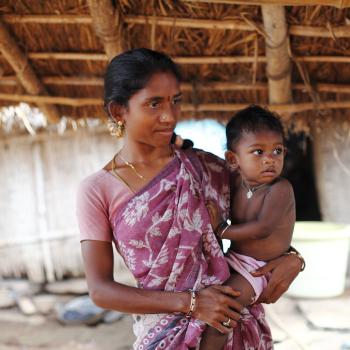
Young Lives India and the Children’s Investment Fund Foundation (CIFF) in collaboration with the International Center for Research on Women (ICRW) today launched a series of research and policy findings on child marriage and teenage pregnancy.
The meeting brings together experts, academics and policy makers working on issues of gender, youth and adolescence, and specifically on early marriage. Based on research findings from Young Lives and a baseline study of an integrated community-based initiative for adolescent empowerment by ICRW in Dholpur, Rajasthan, experts and government officials discussed key strategies and recommendations for reducing early marriage and teenage pregnancy.
The key findings show that:
- 28% of girls in the Young Lives Older Cohort were married before the age of 18. Only 1% of boys had married before 18 years.
- 59% of married girls had given birth to their first child by the age of 19. All recorded births had happened in wedlock.
- Girls who had left school by age 15 were four times more likely to marry before the age of 18 than girls who were still in school at age 15.
- Girls from the poorest households were twice as likely as girls from the least-poor households to be married before the age of 18.
- Girls whose parents had the lowest educational aspirations for their daughters at age 12 were twice as likely be married before age 18, compared with girls whose parents had the highest educational aspirations for them.
The research-policy programme initiated by Young Lives India and supported by CIFF, intends to strengthen adolescent reproductive health and well-being in India.
Talking about the findings from Young Lives India, Mr Hisham Mundol, Executive Director Strategy & Partnerships at CIFF said
Given the importance the Government of India has given to tackling child marriage and teenage pregnancy, it is critical to foster greater collaboration across various promising initiatives such as Rashtriya Kishor Swasthya Karyakram (RKSK) and Beti Bachao Beti Padhao to address the needs of adolescent girls. Special attention needs to be given to provision of social protection to the poorest families, so that girls are given an opportunity to complete secondary education and reduce financial pressure to marry their daughters early. Access to sexual and reproductive health services is also necessary to enable young couples to delay the first pregnancy’.
The research and policy papers launched today include Factors Shaping Trajectories to Child and Early Marriage, Teenage Marriage, Fertility, and Well-being: Panel Evidence from India and Tackling Child Marriage and Early Childbirth in India: Lessons from Young Lives.
Dr Renu Singh, Country Director, Young Lives, India said
‘Ministries like MWCD, MoHFW, MHRD , Labour and local and legal institutions like Panchayati Raj institutions and Child Protection Committees should actively work with young people in preventing child marriages and early pregnancies. As well as working with women and girls, our research suggests that effective engagement is needed with boys, men and the wider community, given their important role in decision-making’.

Young Lives India and the Children’s Investment Fund Foundation (CIFF) in collaboration with the International Center for Research on Women (ICRW) today launched a series of research and policy findings on child marriage and teenage pregnancy.
The meeting brings together experts, academics and policy makers working on issues of gender, youth and adolescence, and specifically on early marriage. Based on research findings from Young Lives and a baseline study of an integrated community-based initiative for adolescent empowerment by ICRW in Dholpur, Rajasthan, experts and government officials discussed key strategies and recommendations for reducing early marriage and teenage pregnancy.
The key findings show that:
- 28% of girls in the Young Lives Older Cohort were married before the age of 18. Only 1% of boys had married before 18 years.
- 59% of married girls had given birth to their first child by the age of 19. All recorded births had happened in wedlock.
- Girls who had left school by age 15 were four times more likely to marry before the age of 18 than girls who were still in school at age 15.
- Girls from the poorest households were twice as likely as girls from the least-poor households to be married before the age of 18.
- Girls whose parents had the lowest educational aspirations for their daughters at age 12 were twice as likely be married before age 18, compared with girls whose parents had the highest educational aspirations for them.
The research-policy programme initiated by Young Lives India and supported by CIFF, intends to strengthen adolescent reproductive health and well-being in India.
Talking about the findings from Young Lives India, Mr Hisham Mundol, Executive Director Strategy & Partnerships at CIFF said
Given the importance the Government of India has given to tackling child marriage and teenage pregnancy, it is critical to foster greater collaboration across various promising initiatives such as Rashtriya Kishor Swasthya Karyakram (RKSK) and Beti Bachao Beti Padhao to address the needs of adolescent girls. Special attention needs to be given to provision of social protection to the poorest families, so that girls are given an opportunity to complete secondary education and reduce financial pressure to marry their daughters early. Access to sexual and reproductive health services is also necessary to enable young couples to delay the first pregnancy’.
The research and policy papers launched today include Factors Shaping Trajectories to Child and Early Marriage, Teenage Marriage, Fertility, and Well-being: Panel Evidence from India and Tackling Child Marriage and Early Childbirth in India: Lessons from Young Lives.
Dr Renu Singh, Country Director, Young Lives, India said
‘Ministries like MWCD, MoHFW, MHRD , Labour and local and legal institutions like Panchayati Raj institutions and Child Protection Committees should actively work with young people in preventing child marriages and early pregnancies. As well as working with women and girls, our research suggests that effective engagement is needed with boys, men and the wider community, given their important role in decision-making’.

